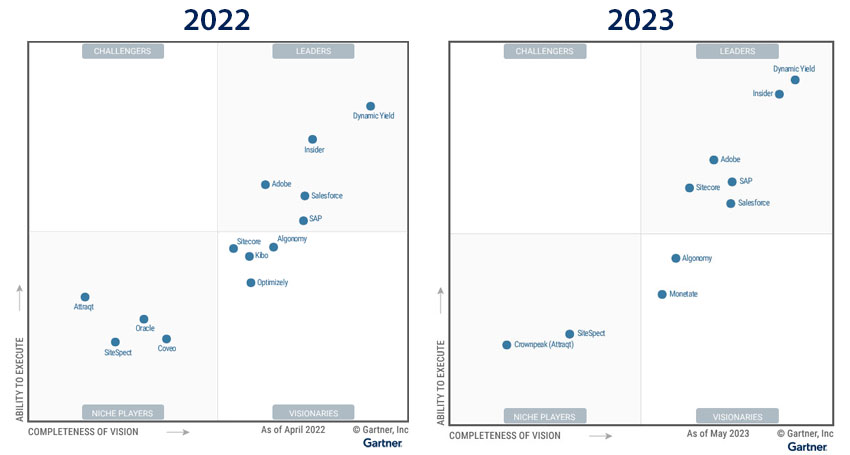Hyper-personalization initiatives are in vogue as CX teams become more strategic around individual customers and leverage their data in new ways.
Dynamic pricing and discounting, timely engagements, and real-time product notifications are examples of how brands are doing so.
Behind these use cases are personalization engines, which vendors are increasingly infusing with AI to add more personal touches across the customer lifecycle.
However, some vendors are going to greater lengths than others, pushing the boundaries of innovation while maintaining customer value.
In its Magic Quadrant, Gartner evaluated ten prominent providers of personalization engines, isolating six market leaders that are doing precisely that.
The Definition of Personalization Engines
Personalization engines allow marketing teams to devise the optimal experience for an individual customer by leveraging in-house and third-party data.
That data – including purchase histories, contact reasons, and demographic information – feeds the engine with vital customer context.
From there, businesses may deliver communications – such as offers, promos, and other content – through the best-placed digital channel.
Such communications typically fit into three buckets: marketing, digital commerce, and service/support – and Gartner expects providers to serve up use cases across each.
Moreover, the analyst lists the following as core capabilities of a personalization engine:
- Live behavior tracking, data collection, and ingestion features
- Interaction triggers based on real-time customer context
- Flexible user segmentation to support dynamic rules
- Testing features to trial various personalization tactics
- Predictive analytics features to present relevant content at the optimal moment
- Performance tracking of various personalization initiatives
There are also optional capabilities, such as support for account-based data structures, machine learning to improve personalization outcomes, and voice of the customer (VoC) tools.
Additional differentiative features also rise to the fore inside Gartner’s evaluation of each provider’s strengths and cautions.
Once the analyst weighed all these up, it split each vendor into four groups: Leaders, Challengers, Visionaries, and Niche Players.

Gartner Magic Quadrant Leaders
Leaders in the Magic Quadrant prioritize customer success, offering scalable, user-friendly solutions that don’t have a steep learning curve. Beyond this current execution, they also provide a well-defined roadmap demonstrating a deep understanding of the market’s direction and safeguarding buyer investments. This year’s leaders are:
- Dynamic Yield
- Insider
- Adobe
- SAP
- Salesforce
- Sitecore
Dynamic Yield
The strategic vision and innovation on display within the evolution of Dynamic Yield’s Experience OS platform impresses Gartner. Indeed, the analyst highlights how marketers can seamlessly compose and execute scalable personalization strategies using an intuitive dashboard. Moreover, it isolates product/content promotion and testing as differentiators for Dynamic Yield. The latter includes a visual editor, live preview, and AI/ML features for content generation and customer affinity matching.
Insider
Insider offers superior tools for engaging aimless customers trawling the website. How? Through personalized search results, configurable experience (inc. swipeable templates), a quiz commerce engine, and more. Garter applauds these additions to the browsing experiences while commending Insider’s comprehensive roadmap, guided selling, and interactive product recommendations. The latter crosses many digital channels, including WhatsApp, with the vendor even condensing entire commerce journeys into the app.
Adobe
Adobe Target offers real-time personalization across many platforms. These include websites, apps, contact centers, digital kiosks, contact centers, and even vehicle screens. Such flexibility allows Adobe to bring new personalization opportunities to marketing, service, and commerce environments. Gartner notes this as a core strength of the platform, alongside its testing features and scalability. Also, as part of Adobe Experience Cloud, the engine benefits from a robust partner ecosystem, global operations base, and flat-fee pricing.
SAP
SAP Emarsys has “market-leading” measurement capabilities, according to Gartner. Indeed, its reporting dashboards uniquely offer out-of-the-box reporting personas alongside advanced customization options and alert thresholds for specific KPIs. The Magic Quadrant report also isolates targeting, triggering, and journey orchestration as major plusses of the Emarsys solution. Finally, SAP supports audience data sharing with various CRM and social media platforms for enhanced targeting.
Salesforce
The Salesforce Marketing Cloud Personalization engine links with the CRM leader’s broader ecosystem for greater personalization across customer-facing functions. For instance, it also enables tailored recommendations in Service Cloud and personalized emails with Journey Builder. Salesforce wins plaudits for spreading such capabilities across the customer lifecycle, its differentiative B2B personalization features, and ecosystem interoperability from Gartner. The vendor recently improved this interoperability further with the Einstein 1 platform launch.
Sitecore
Sitecore impresses Gartner with its commitment to client success, setting a fixed scope to reach pre-agreed and -defined outcomes. Moreover, its Sitecore360 platform has become more relevant across various industries thanks to its enhanced content search, audience sharing, and unified cross-channel tracking. Lastly, the analyst highlights the engine’s advanced decisioning as a differentiator, with its unique decision canvas that accommodates diverse client use cases.
Gartner Magic Quadrant Challengers
Challengers in the Magic Quadrant can showcase a track record for successful deployments that exceed expectations. Yet, they are sometimes limited by a narrow market focus or lack of coordination across their portfolio. Alternatively, the potential drawbacks are sales channel limitations, geographic presence, and/or awareness. This year’s challengers are:
- There are no challengers in this year’s Magic Quadrant.
Gartner Magic Quadrant Visionaries
Visionaries in the Magic Quadrant possess a distinctive vision for marketing personalization and often excel in specific areas with advanced capabilities. That said, they sometimes have gaps in broader capabilities or receive lower ratings in CX, support operations, and sales execution. As such, consistent execution is a caution for these innovators. This year’s visionaries are:
- Algonomy
- Monetate
Algonomy
Algonomy excels in its “touchpoint coordination”, with Gartner commending its journey canvas and multichannel experience orchestration. Its advances in algorithmic decisioning and no-code builders are also significant plusses, with the latter enabling guided selling, audience building, and recommendation strategies. However, the analyst cites customer reviews that underscore the platform’s complexity and the requirement for “comprehensive” training for optimal adoption.
Monetate
Monetate earns plaudits for its forward-thinking action builders, tailored recommendations, and customized services. The former enables code-free customization of diverse digital experiences by inserting, editing, or hiding elements based on web visitor profiles and actions. Meanwhile, its tailored recommendations impress with features like audience filtering, product burying, and algorithm testing. Nevertheless, Gartner cites its buy-out by Lane Partners as a concern, seemingly consuming technical and account resources.
Gartner Magic Quadrant Niche Players
Niche players in the Magic Quadrant typically excel in specific verticals but often lack depth in their broader functionality. In addition to these platform feature gaps, they may trail due to limited customer feedback or lack of implementation support services. These are critical inhibitors to growing their install bases. This year’s niche players are:
- SiteSpect
- Crownpeak (Attraqt)
SiteSpect
SiteSpect stands out for its robust experimentation capabilities and remote-app personalization. The platform also offers a strong foundation for evolving testing strategies with a visual editor workflow. Meanwhile, it provides proof of concept engagements, 24/7 customer support, and a dedicated optimization team. However, Gartner cautions as to the breadth and velocity of its roadmap, steep technical learning curve, and limited orchestration capabilities.
Crownpeak (Attraqt)
Crownpeak (formerly Attraqt) delivers personalized recommendations across the web, mobile apps, and email, exemplifying its strength in product discovery. Gartner also highlights its success in retail, designing popular eCommerce and discovery solutions that underline its sector expertise. Nonetheless, the analyst warns prospective B2B buyers with long sales cycles should think twice when assessing whether the solution meets their core needs. Meanwhile, its triggering capabilities and support resources are additional cautions.
How does the Magic Quadrant Compare to 2023?
In 2023, Dynamic Yield and Insider surged towards the top right of the quadrant, extending their market lead.
Meanwhile, Sitecore joined these vendors in the leader quadrant after Gartner named the vendor a visionary last year – as shown below.

SAP also gained ground – remaining in the leader square alongside Adobe and Salesforce.
Other than that, little has changed. Although, 2022 niche players Oracle and Coveo, in addition to visionary Optimizely, dropped out of the quadrant entirely.
Oracle sunset its testing features (a critical capability in the report), Coveo failed to demonstrate the necessary industry breadth, and Optimizely also failed to meet all the required criteria.
Check out some of our other 2023 Magic Quadrant report rundowns below:
- Gartner Magic Quadrant for Multichannel Marketing Hubs 2023
- Gartner Magic Quadrant for the CRM Customer Engagement Center 2023
- Gartner Magic Quadrant for Digital Experience Platforms 2023






